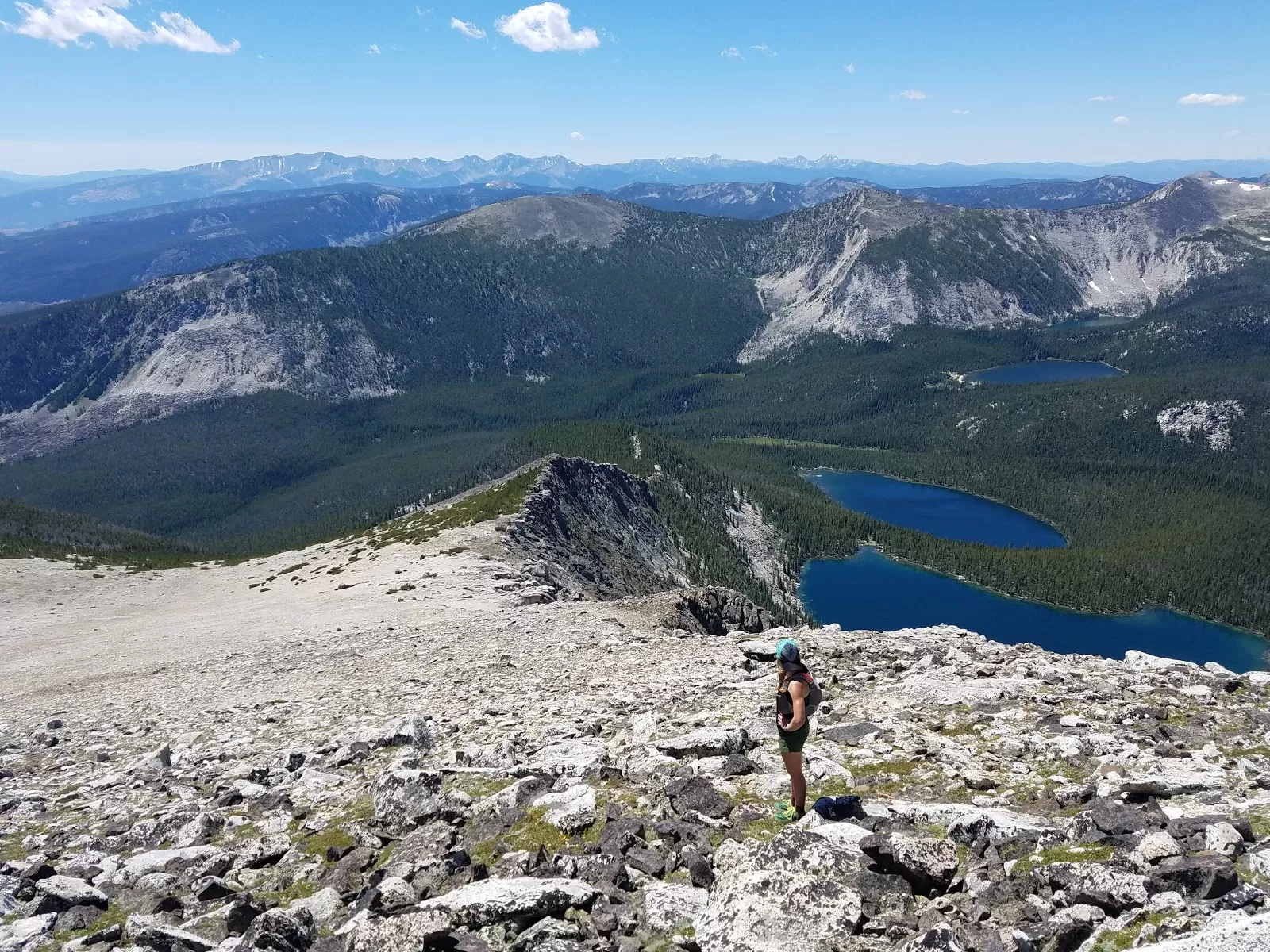
Image credit: pixabay (free license)
This photo of Mt. Powell (10,168 ft. or m) in western Montana shows an impressive cirque, shaped by a glacier that once flowed from Powell's northeast slope, down toward the valley of the Clark Fork River.
According to geology maps, the strange flow-shaped mass of rocks near the bottom of the cirque was left by a rock glacier.
Apparently, during the final decades of Mt. Powell's glacier, there were more rocks than ice in the mix.
Eventually, even the ice between the rocks melted away, and the rocks were left without a ride.
From the summit, the deposit looks like a fluid blob of rocks, but without the matrix of ice the rocks are no longer flowing.
Mount Powell is the highpoint of the Flint Creek Range, a relatively unknown range just west of Deer Lodge, MT along I-90. This one has a nice combination of everything you'd look for in a good adventure. It's incredibly scenic, there's a healthy mixture of on-trail and off-trail travel, and there's even a nice side quest that you can easily incorporate into the day if you're feeling extra adventurous. The road to the trailhead gets rough in spots so a high-clearance vehicle is recommended although not entirely needed. The trailhead also provides access to Dempsey Basin, a collection of beautiful sub-alpine lakes, which flanks Powell to the southwest. Deer Lodge Mountain is a great side quest which will take you along the edge of giant cirque known as "The Crater".
As one drives along I-90 between Drummond and Deer Lodge, a small group of high, imposing looking mountains dominate the skyline to the south. Despite covering much less acreage than its southern Anaconda-Pintler neighbor, the Flint Creek Range still boasts a few peaks over 10,000' and provides a wonderful view of the Deer Lodge Valley.
The Flint Creek range pulls its name from nearby flint extraction sites, the largest of which is Eyebrow Quarry. Eyebrow Quarry (because initially it looked like a brow of land) contains numerous pits that were used to mine materials for lithic points for thousands of years.1 Much of the rock in the area surrounding the Flint Creek Range formed during the Cambrian area, meaning its been around for a long time. Many Native American groups used flint for various forms of lithic points for hunting and warfare, so it is not much of a surprise that a quarry the size of Eyebrow Quarry exists in a place named for flint.

Image credit: Wikimedia Commons
|
Although, according to the blog "Granite County History," 'flint' isn't technically an accurate name for the rock in the area because flint is a type of chert, which is a sedimentary type of silica, and the rocks in the area are a more hydrothermal version of silica. So the blog asserts that 'Chalcedony Creek' is a more accurate name, but like the author said, isn't as catchy as 'Flint Creek.' Also, by coincidence one of the women who did a lot of work on the Eyebrow Quarry site is Patricia Flint. So 'Flint' it is.
While we were hiking, however, we were more interested in finding the correct drainage to follow off of the ATV road we were walking. Since no part of this range is wilderness area, much of the sub-alpine land is heavily tracked with dirt-bike trails and ATV roads. Above treeline, however, there exists no roads, but also no trails, which requires a challenge while ascending on foot. We were attempting to follow Cedron Jones' description from his Peakbagging Montana book, which sounded really confusing on paper. Fortunately on the ground it made a lot more since and we even found the "strong gametrail" we were hoping to locate, which made for a relatively easy ascent. A quick couple thousand foot climb up a drainage put us on a wonderfully wide ridge and hiking straight north to the summit of Mount Powell.
The ridge gradually got steeper until we faced the last few hundred feet of ascent until we began scrambling over refrigerator size rocks (not mini-dorm-size fridges, full on house fridges) until the top. From the summit of Mount Powell we had a nearly complete view of the Clark Fork River from where it emerges towards Butte and flows into the canyon on the way to Missoula.
The valley below us, which is the home to Deer Lodge and Anaconda, as well as a few other small towns, served as a major transportation artery during the gold days of Montana. Deer Lodge operated as a stage stop and place to refresh horses. Where there is gold there are people who want to steal it and highwaymen chased the yellow rock through this valley, followed by the vigilantes chasing the highwaymen chasing the gold. The 1870's sound exhausting.
Today Deer Lodge is a stop on the highway and home to the Old Montana State Prison museum, and the current Montana State Prison Ranch. More people know of the Flint Creek Range, however, as the range on which Philipsburg sits. According to the Granite County History blog the establishment of the Stewart Gulch Mine in 1866 helped the growth of Philipsburg around a silver claim and cabin owned by Hector Horton. On the western flank of the range, out of site of Mount Powell, Philipsburg is a town past its heyday, but has transitioned into a mining town tourist site. Although you would be hard pressed to discover silver near Philipsburg today, it's still worth stopping in Philipsburg and Deer Lodge simply for the Montana history. Plus there is an excellent candy store in Philipsburg, which is great after a day in the mountains.

